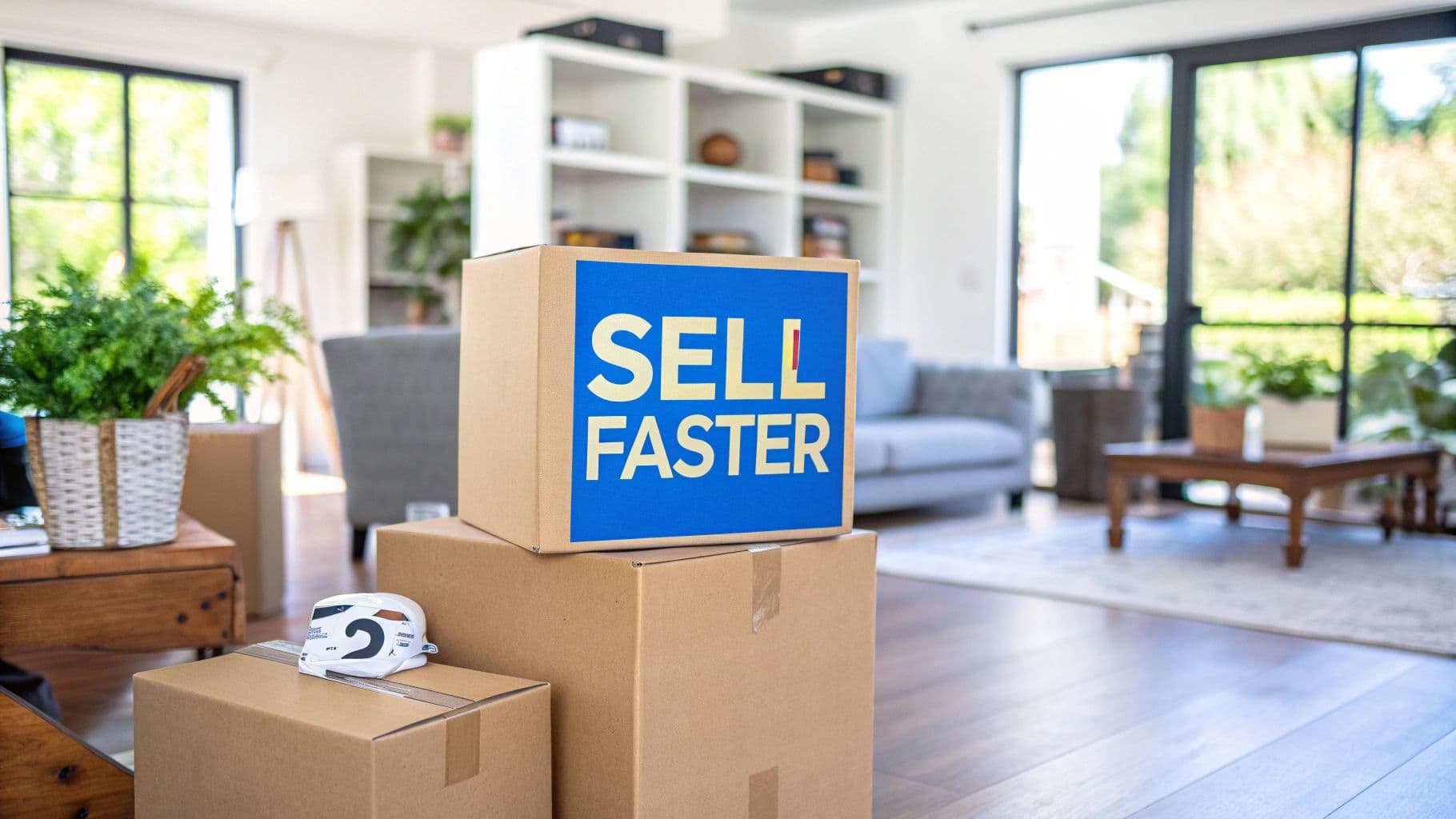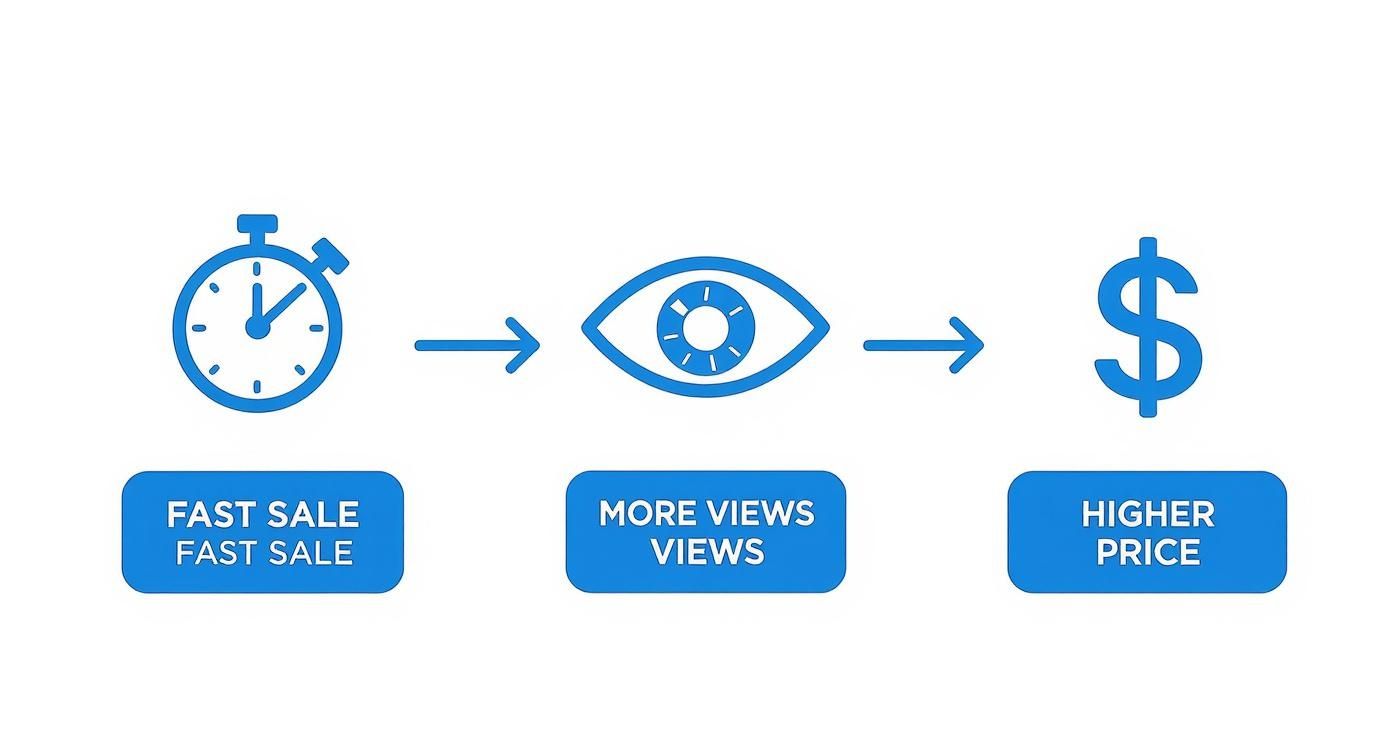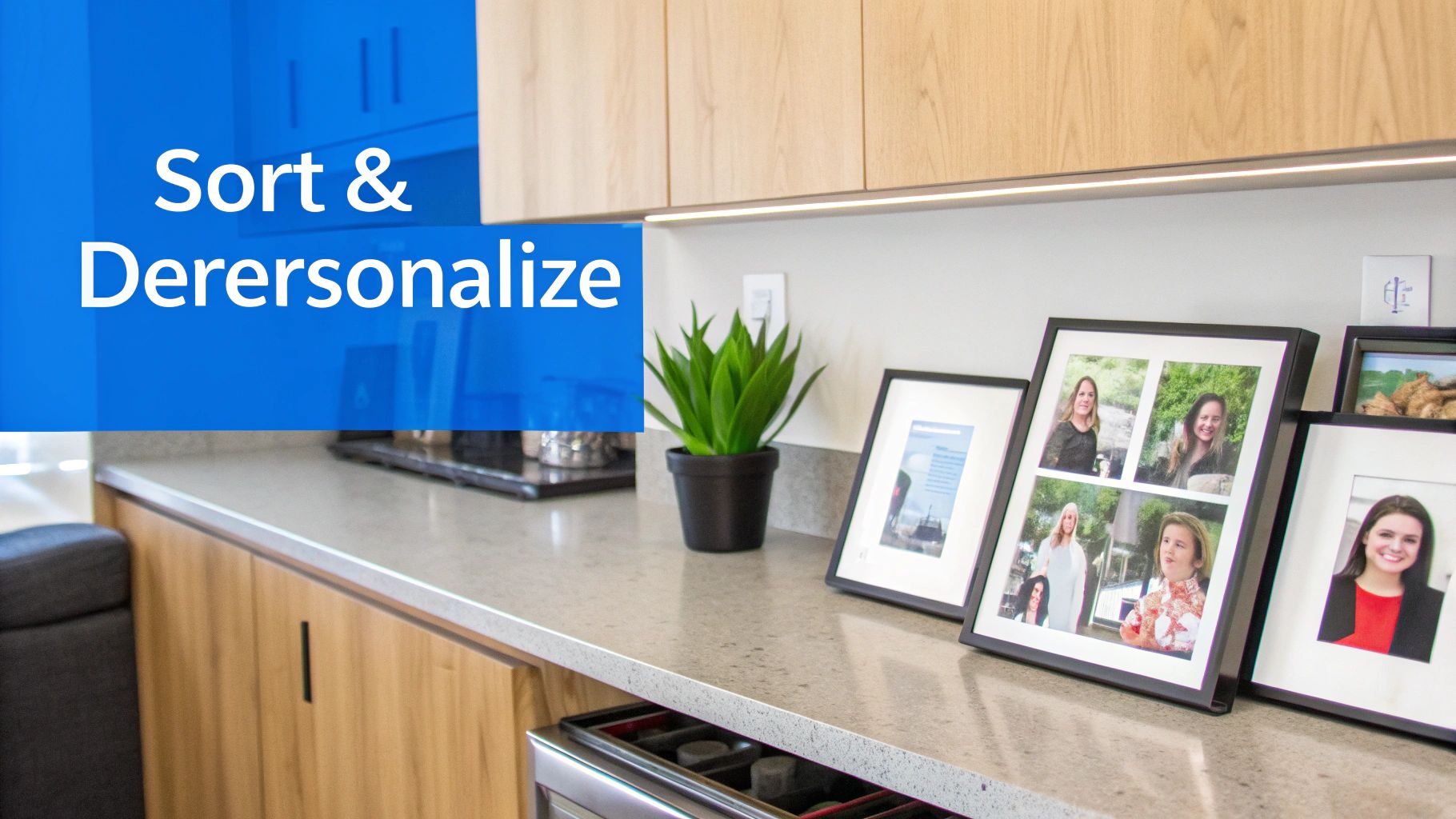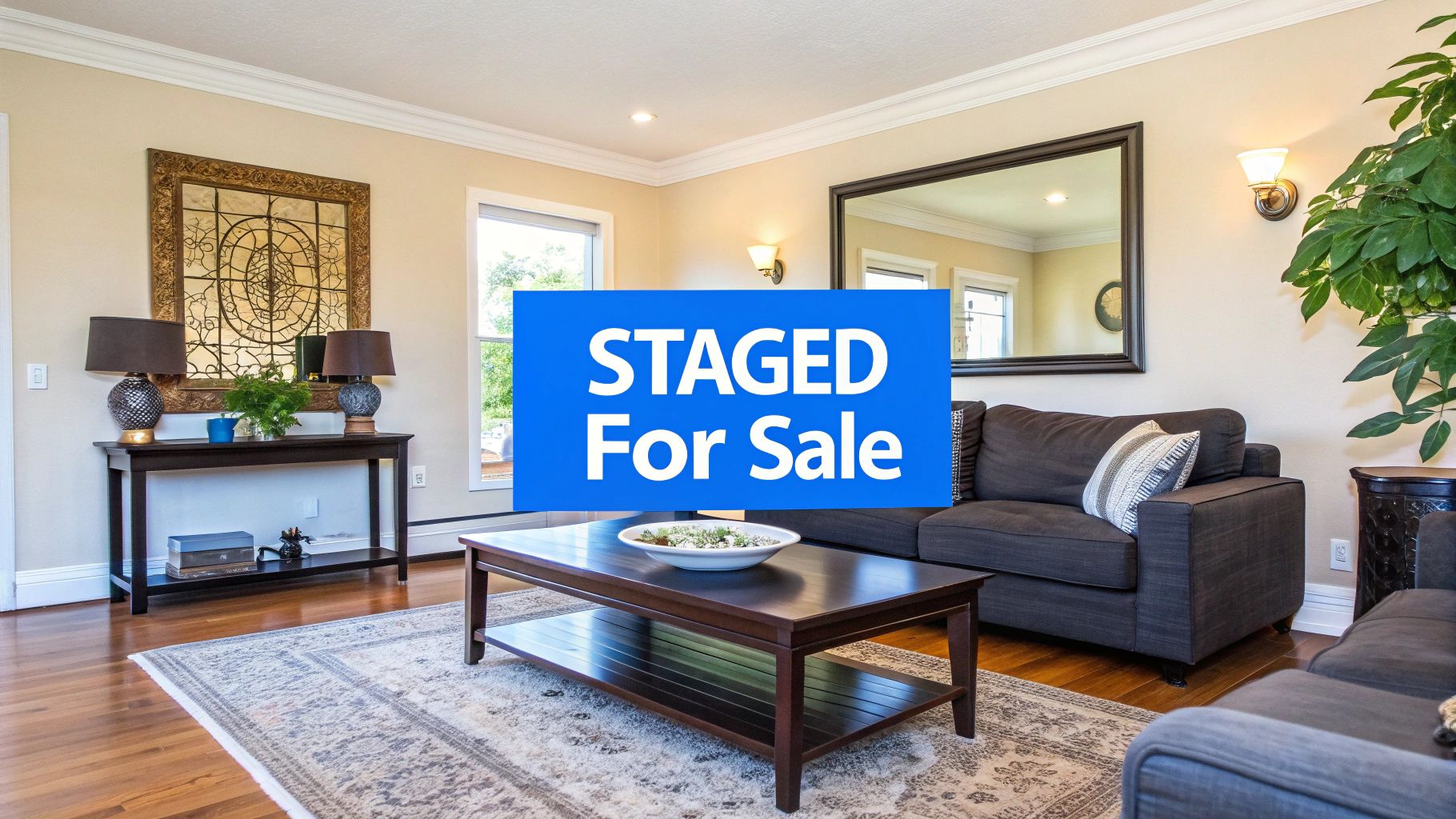Decluttering House for Sale: Quick Tips to Sell Faster

Before you spend a dime on renovations, let’s talk about the single most impactful, low-cost thing you can do to prepare your house for sale: declutter. This isn't just about a weekend tidy-up. It's a strategic move to make rooms feel bigger, let the light in, and show off your home's best features.
Think of it this way: a clutter-free home is a blank canvas. It gives potential buyers the mental space they need to picture their own lives—and their own furniture—in every room.
How Decluttering Unlocks Your Home's True Value
Let's be blunt. Decluttering is an investment that pays for itself almost instantly. When a buyer walks through your front door or, more likely, first scrolls through your listing photos online, you have seconds to make a great impression.
Overflowing bookshelves, crowded kitchen counters, and closets packed to the brim all send one subconscious message: "There isn't enough space here." That perception can kill a deal before it even begins and will almost certainly affect the offers you receive.
By clearing out all that excess stuff, you’re not just selling a house; you’re selling possibility.
From Cluttered to Captivating
The change is dramatic. A decluttered home feels brighter, cleaner, and far better maintained. Suddenly, that beautiful window or the charming architectural details become the main event, instead of being hidden behind stacks of personal belongings.
This simple act of subtraction is one of the most effective strategies to increase property value you can employ. And the numbers don't lie.
Listings with clean, uncluttered photos get up to 61% more views online. Even better, those homes tend to sell about 32% faster than their cluttered neighbors.
What does that mean for your bottom line? On average, sellers who take the time to declutter and depersonalize can see a 3–5% increase in their final sale price. Your effort now translates directly into a faster sale and more money in your pocket.
To give you a clearer picture, here's a quick look at why this step is so critical.
Decluttering Impact at a Glance
| Benefit | Statistical Impact |
|---|---|
| Faster Sale Time | Homes sell up to 32% faster on average. |
| Higher Sale Price | Can increase the final sale price by 3–5%. |
| Increased Online Views | Listings with uncluttered photos attract 61% more views. |
| Larger Perceived Space | Makes rooms appear larger and more open. |
| Highlights Key Features | Allows buyers to see and appreciate the home's architecture. |
| Stronger Buyer Connection | Creates a blank canvas for buyers to envision their future. |
As the data shows, clearing the decks isn't just a "nice-to-do"—it's a foundational part of a successful home-selling strategy.
The Financial Impact of a Clean Slate
Ultimately, every box you pack and every countertop you clear is a deliberate step toward maximizing your profit. You're merchandising your most valuable asset. The time and effort you put in now will pay huge dividends when those offers start rolling in.
Your Room-by-Room Decluttering Game Plan
Staring at a whole house that needs to be decluttered can feel completely paralyzing. Where do you even start? The secret is to stop thinking of it as one monster project and break it down into a series of smaller, more manageable tasks. A systematic, room-by-room approach turns an overwhelming chore into a string of satisfying wins.
Forget about randomly picking at piles. You need a clear strategy. I always recommend starting with the rooms that create the biggest first impression for a buyer, like the living room and kitchen. Block out specific chunks of time for each room and, most importantly, stick to your schedule. This is how you build momentum and avoid burning out.
This isn't just about making the place look tidy; it's a direct line to a better sale.

As you can see, a clean, organized space is the foundation. It’s what leads to a top-dollar offer in less time.
Adopt The Four-Box Method
To make quick, decisive choices, you need a system. Grab four large boxes or just designate four corners of the room and label them: Keep, Donate/Sell, Store, and Discard. As you handle each item, make an immediate decision—your gut instinct is usually right—and put it in its place.
- Keep: For essential, everyday items that will be part of the staging.
- Donate/Sell: For anything in good shape that you simply don’t need anymore.
- Store: For personal keepsakes, family photos, and anything off-season that clutters the space. These will go into a storage unit or be neatly packed away.
- Discard: For anything broken, expired, or unusable. Trash it.
This method forces you to be methodical and stops the all-too-common habit of just shuffling clutter from one room to the next. It’s an incredibly powerful tool when you’re decluttering a house to sell.
Remember the goal: create a neutral, inviting space. If an item doesn't serve a functional or decorative purpose for staging, it has to go into one of the other three boxes. No exceptions.
Focus on High-Impact Areas First
You only have so much energy, so use it where it counts. Buyers form their strongest opinions based on the main living areas. Tackling these rooms first gives you the biggest visual bang for your buck.
Start in the kitchen. Clear 100% of the countertops. Seriously. Pack away the toaster, the knife block, the utensil crock. A buyer wants to see expansive counter space, not your coffee maker. From there, move to the living room and depersonalize it by removing family photos, memorabilia, and any quirky decor.
Closets are another non-negotiable. Buyers will open them to check out storage space. If a closet is jammed full, it sends a clear signal that the house doesn't have enough storage. If you need some targeted advice, there are great guides on how to declutter your closet for good.
For a complete plan that covers every part of the home, our detailed room-by-room declutter checklist will walk you through the entire process, making sure you don’t miss a thing. By following this strategic plan, you’ll create a vision that potential buyers can’t resist.
Mastering the Art of Sorting and Depersonalizing
Once your plan is locked in, the real work begins. It’s time to decide what stays and what goes. This isn't just a weekend tidy-up; you're strategically editing your home to make it irresistible to the widest audience of buyers. The mission is to create a space that feels clean, spacious, and like a blank canvas for its next owner.
The first, and maybe most important, rule is to depersonalize aggressively. Buyers need to imagine their own lives unfolding in your space, and that's nearly impossible when they’re looking at your family vacation photos, your kids' art on the fridge, and your prized collection of ceramic frogs. These items are precious to you, but to a buyer, they’re just noise.

Go Beyond Tidying and Start Curating
Start thinking of your house less like a home and more like a product on a shelf. To make it stand out, you have to simplify the presentation. That means applying some firm rules to every single surface.
- Kitchen Counters: Your goal is to clear at least 75% of your countertops. Pack away the coffee maker, the toaster, the knife block, and that overflowing utensil holder. A bowl of fresh lemons or a single small plant is all you need.
- Bookshelves: Overstuffed bookshelves feel heavy and make a room look smaller. Pull at least half the books off the shelves. Create some visual breathing room by stacking a few horizontally and adding a simple, impersonal object.
- Closets and Cabinets: Oh, they will look. Buyers are nosy, and they want to see how much storage space they're getting. You need to remove enough stuff so that shelves are no more than two-thirds full. This creates the powerful illusion of abundant storage.
I get it—the emotional side of this is tough. Letting go of sentimental things is never easy, but you're not tossing them forever. If you’re feeling stuck, there are great resources that can offer some help with decluttering and make it all feel more manageable. A fantastic pro tip? Rent a small, short-term storage unit. It's the perfect way to keep your cherished belongings safe and out of sight while your home is on the market.
The True Cost of Keeping 'Just in Case' Items
Hanging onto all that stuff you might need one day has a very real financial cost. Hidden in those "just in case" piles is a massive opportunity cost. A report from Storable and SpareFoot found that 54% of Americans use 100–500 square feet of their home just to store things they barely touch.
Think about that. With the median U.S. home price per square foot hovering around $227, dedicating a mere 300 square feet to storage is like giving away $68,100 in real estate value. You can dig into more of the fascinating numbers in this report on the hidden costs of household clutter.
Letting go of clutter isn't just about creating space; it's about reclaiming your home's financial value. Every square foot you clear is a tangible asset you can present to buyers.
This is never more true than when you’re selling your house. Clearing out that excess inventory doesn't just recapture usable space; it transforms cramped, forgotten corners into valuable, functional zones that buyers will absolutely pay a premium for.
Smart Strategies for Your Unwanted Items
You’ve done the hard work of sorting, and now you’re staring at three distinct piles: sell, donate, and store. This is where the magic happens. You’re about to turn that clutter into either cash or good karma, all while making your home look bigger and more appealing for showings. The goal here is to be decisive and strategic.
Let's start with the fun part—the items you’ve decided to sell. Putting a little extra money in your pocket during a move is always a win, and today’s online world makes it surprisingly simple.
Cashing in on Your Clutter
Selling your stuff has never been easier, especially for furniture, electronics, and home decor that are in great shape but just don't fit your staging plan. Platforms like Facebook Marketplace and OfferUp are fantastic for local sales. They connect you directly with buyers in your area, making a quick pickup pretty painless.
Got some higher-end furniture or designer pieces? Consider a local consignment shop. They do all the heavy lifting—managing the listing, dealing with buyers—and just take a commission. It's a great hands-off option when you're already juggling a dozen other things. If you want to really get into the weeds, there's tons of good advice on how to sell household items online and get the best price.
Donating for a Good Cause
For everything else that’s in good, usable condition, donation is the fastest way to clear space. It feels great, it’s quick, and you're helping out your local community. Organizations are always looking for quality goods.
- Goodwill and The Salvation Army: These are my go-to spots for clothing, small appliances, books, and general household items. Most towns have convenient drop-off locations.
- Habitat for Humanity ReStores: Have larger items like furniture, leftover building materials, or working appliances? ReStores are a perfect fit. They sell these items to fund their home-building projects for families in need.
Don’t forget to keep a detailed list of what you donate and always ask for a receipt. The value of your donated items is often tax-deductible, turning your decluttering into a nice little financial bonus come tax season.
The Storage Unit Debate
Now, let's talk about the "Store" pile—this is for your personal keepsakes, off-season clothes, and anything you absolutely love but know makes your rooms feel crowded. So, is a short-term storage unit actually worth the cost? In my experience, absolutely.
Think of it as part of your staging budget. For a small monthly fee, you can completely empty out closets, clear the garage, and remove that bulky armchair that makes the living room feel small. Trust me, buyers will look in your closets. A neat, half-empty closet sends a powerful message: "This home has plenty of storage space." That’s a huge selling point. The small investment in a storage unit almost always pays for itself by helping you land a faster, higher offer on your home.
Turning Your Decluttered Space Into a Staged Home

This is where all your hard work pays off. You've sorted, purged, and packed, which means you're now standing in a clean, spacious canvas. The final goal is to turn that canvas into an irresistible home that buyers can immediately picture themselves in. Staging is the bridge between an empty space and an emotionally captivating one.
And don't worry—staging isn't about renting expensive furniture or redecorating from scratch. It’s the art of strategic placement. It’s about using the furniture and decor you’ve decided to keep to highlight your home’s best features, create an intuitive flow, and make every corner feel bright and full of purpose. All the effort you put into decluttering your house for sale was the perfect setup for this critical final touch.
Create an Irresistible Flow
First things first: arrange the remaining furniture to maximize the feeling of space. Try pulling furniture away from the walls to create cozy, conversational groupings in the living room. It's a simple trick, but it makes a room feel larger and more inviting, rather than looking like a doctor's waiting room.
Make sure there are clear, obvious pathways through each room. A potential buyer should never have to shuffle sideways around a coffee table or squeeze past an armchair. The journey through your home should feel effortless, guiding them naturally from one space to the next.
Let the Light In
Natural light is one of your most powerful selling tools, and it costs absolutely nothing. Your staging efforts should revolve around making the most of it.
- Window Treatments: Open every blind and curtain. If you have heavy, dark drapes that swallow light, consider taking them down completely. Let that sunshine pour in.
- Mirror Magic: Place a large mirror on a wall directly opposite a window. It will bounce light all around the room and reflect the view, making the space feel instantly brighter and bigger.
- Clear the Sills: Remove any plants, photos, or knick-knacks from your windowsills. You want an unobstructed view and a clear path for the light.
These small tweaks can completely change the atmosphere of a room, making it feel more cheerful and spacious—a huge win with buyers.
Home staging, built on a solid foundation of decluttering, is one of the few strategies proven to boost sale prices. It creates an emotional connection that helps buyers commit.
The numbers back this up. Home staging is one of the only real estate strategies that reliably increases sale prices and gets a home sold faster. In fact, 29% of real estate agents report that staged homes sell for 1–10% more, and 49% see a significant drop in the time a home spends on the market. The living room, primary bedroom, and kitchen are the rooms with the biggest impact. You can read the full research about home staging's impact on NAR's website to see all the details.
Add Simple, Neutral Touches
Finally, add a few thoughtful details that make the house feel like a well-cared-for home—without making it feel your home. Think of it like adding touches you'd see in a boutique hotel.
A bowl of fresh green apples or lemons on the kitchen counter adds a perfect pop of color. In the bathrooms, set out a stack of fresh, fluffy white towels and a new bar of soap. These little things send a powerful message: this home is clean, fresh, and move-in ready. It helps buyers see the incredible potential in the space you’ve so carefully prepared.
Your Top Decluttering Questions, Answered
Even with the best game plan, a few nagging questions always seem to surface right when you're in the thick of it. Getting stuck on these little details can really slow you down, especially when you're on a tight schedule to get your house on the market.
Let's clear up some of the most common uncertainties people have when prepping a home for sale. Getting these answers now will save you a ton of stress and second-guessing down the road.
How Long Does This Actually Take?
Honestly? It depends entirely on the size of your home and how much stuff you’ve accumulated over the years. But for a typical three-bedroom house, you should budget two to four full weekends of solid, focused work.
The trick is to start early—at least a month or two before you even think about listing. This gives you breathing room and prevents that panicked, last-minute scramble. You can tackle one small area at a time, like a single closet or the kitchen pantry, instead of trying to do it all in one exhausting marathon session. Slow and steady really does win this race.
Is a Storage Unit Really Worth the Money?
For almost every single seller, the answer is a hard yes. Don't think of it as an expense; it’s a smart investment in how your home shows to potential buyers.
A storage unit is your secret weapon for stashing bulky furniture that shrinks a room, personal photos that distract from the space, and all that off-season gear cramming your closets. Trust me, buyers will open your closets, pantry, and garage. When they see neat, half-empty spaces, it sends a powerful message that the home has plenty of storage.
The potential for a faster sale and a higher offer almost always outweighs the modest monthly cost of a storage unit. It's one of the smartest moves you can make.
Where Do I Even Start? What Rooms Matter Most?
You want to put your energy where it will have the biggest emotional impact on a buyer. Real estate pros are all on the same page about the top three priority zones:
- The Living Room: This is where buyers mentally move in first. It's where they picture themselves relaxing after a long day or hosting friends. A clean, open living room sets a fantastic tone for the rest of the tour.
- The Kitchen: For so many people, the kitchen is the heart of the home and a huge selling point. When you clear off the countertops, it makes the space feel more functional, more gourmet, and instantly more valuable.
- The Primary Bedroom: This needs to feel like a peaceful retreat, not a storage locker. An uncluttered bedroom helps buyers imagine it as their own private sanctuary.
Once you’ve nailed these three high-impact areas, you can move on to bathrooms and then tackle the bigger storage zones like the garage or basement. This focused strategy ensures your hard work pays off big time.